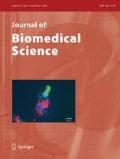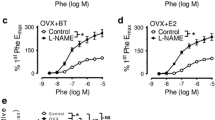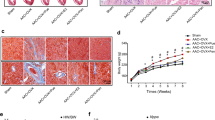Abstract
The goal of the present study is to investigate the role of tetrahydrobiopterin (BH4) in the vascular response in ovariectomized rats. Rats were randomly assigned to two groups: (1) sham group: sham-operated female rats, and (2) Ovx group: rats were ovariectomized. Our results have shown that the plasma 17β-estradiol levels in the Ovx group at the end of the experiment were significantly lower than in the sham group. Vasoreactivity assessed with intact aortic rings indicated that the phenylephrine-induced vasocontractile response to aortic rings from the Ovx group was greater than that of the sham group. In contrast, the vasodilator responses to acetylcholine andL-arginine (L-Arg) in the sham group were significantly greater than in the Ovx group. Differences in vasoreactivity in denuded aorta between the two groups were not noted. Moreover, exogenous BH4 significantly restoredL-Arg-induced vasodilator responses in the Ovx group. However, this improvement effect was not found in the sham group. In addition, there were significant increases in superoxide anion production in aortic tissue and significant decreases in plasma nitric oxide levels in the Ovx group. Furthermore, BH4 contents in the aorta in the Ovx group were significantly decreased compared with the sham group. In conclusion, the present study demonstrates that the impairment of vascular reactivity was found in the ovariectomized rats. The possible mechanism of this defect may have resulted from the deficiency of available BH4. Thus, this study may provide a novel therapeutic strategy for the treatment of postmenopausal cardiovascular disorders.
Similar content being viewed by others
References
Arnal JF, Clamens S, Pechet C, Negre-Salvayre A, Allera C, Girolami JP, Salvayre R, Bayard F. Ethinylestradiol does not enhance the expression of nitric oxide synthase in bovine endothelial cells but increases the release of bioactive nitric oxide by inhibiting superoxide anion production. Proc Natl Acad Sci USA 93:4108–4113;1996.
Barbacanne MA, Rami J, Michel JB, Souchard JP, Philippe M, Besombes JP, Bayard F, Arnal JF. Estradiol increases rat aorta endothelium-derived relaxing factor (EDRF) activity without changes in endothelial NO synthase gene expression: Possible role of decreased endothelium-derived superoxide anion production. Cardiovasc Res 41:672–681;1999.
Barrett-Connor E, Bush TL. Estrogen and coronary heart disease in women. JAMA 265:1861–1867;1991.
Bolego C, Cignarella A, Ruzza R, Zaarour C, Messi E, Zanisi M, Puglisi L. Differential effects of low- and high-dose estrogen treatments on vascular responses in female rats. Life Sci 60:2291–2302;1997.
Cosentino F, Katusic ZS. Tetrahydrobiopterin and dysfunction of endothelial nitric oxide synthase in coronary arteries. Circulation 91:139–144;1995.
Cosentino F, Patton S, d'Usclo LV, Werner ER, Werner-Felmayer G, Moreau P, Malinski T, Luscher TF. Tetrahydrobiopterin alters superoxide and nitric oxide release in prehypertensive rats. J Clin Invest 101:1530–1537;1998.
Furchgott RF, Zawadzki JV. The obligatory role of endothelial cells in the relaxation of arterial smooth muscle by acetylcholine. Nature 288:373–376;1988.
Ghanam K, Javellaud J, Ea-Kim L, Oudart N. The protective effect of 17β-estradiol on vasomotor responses of aorta from cholesterol-fed rabbit is reduced by inhibitors of superoxide dimutase and catalase. Biochem Biophys Res Commun 249:858–864;1998.
Giovanelli J, Campos KL, Kaufman S. Tetrahydrobiopterin, a cofactor for rat cerebellar nitric oxide synthase, does not function as a reactant in the oxygenation of arginine. Proc Natl Acad Sci USA 88:7091–7095;1991.
Heinzel B, John M, Klatt P, Bohme E, Mayer B. Ca2+/camodulin-dependent formation of hydrogen peroxide by brain nitric oxide synthase. Biochem J 281:627–630;1992.
Hong HJ, Loh SH, Yen MH. Suppression of development of hypertension by the inhibitor of inducible nitric oxide synthase. Br J Pharmacol 131:631–637;2000.
Hong HJ, Xiao G, Cheng TH, Yen MH. Supplements of tetrahydrobiopterin suppress the development of hypertension in spontaneously hypertensive rats. Hypertension 38:1044–1048;2001.
Ignarro LJ, Lippton H, Edwards JC, Baricos WH, Hyman AL, Kadowitz PJ, Gruetter CA. Mechanism of vascular smooth muscle relaxation by organic nitrates, nitrates, nitroprusside and nitric oxide: Evidence for the involvement of S-nitrosothiol as active intermediates. J Pharmacol Exp Ther 218:739–749;1981.
Ignarro LJ, Buga GM, Wood KS, Byrns RE, Chaudhuri G. Endothelium-derived relaxing factor produced and released from artery and vein is nitric oxide. Proc Natl Acad Sci USA 84:9265–9269;1987.
Kerr S, Brosnan MJ, McIntyre M, Reid JL, Dominiczal AF, Hamilton CA. Superoxide anion production is increased in a model of genetic hypertension: Role of the endothelium. Hypertension 33:1353–1358;1999.
Kinoshita H, Milstien S, Wambi C, Katusic ZS. Inhibition of tetrahydrobiopterin biosynthesis impairs endothelium-dependent relaxations in canine basilar artery. Am J Physiol 273:H718-H724;1997.
Knoweles RG, Moncada S. Mammalian nitric oxide synthase. Biochem J 298:249–258;1994.
Laursen JB, Rajagopalan S, Galis Z, Tarpey M, Freeman BA, Harrison DG. Role of superoxide in angiotensin II-induced but not catecholamine-induced hypertension. Circulation 95:588–593;1997.
Mackenize A, Martin W. Loss of endothelium-derived nitric oxide in rabbit aorta by oxidant stress: Restoration by superoxide dismutase mimetics. Br J Pharmacol 124:719–728;1998.
Magness RR, Rosenfeld CR. Local and systemic estradiol-17β: Effects on uterine and systemic vasodilation. Am J Physiol 256:E536-E542;1989.
Martin JK, Ellis RL. Rapid actions of plasma membrane estrogen receptors. Trends Endocrinol Metab 12:152–156;2001.
Mayer B, Werner E. In search of a function for tetrahydrobiopterin in the biosynthesis of nitric oxide. Naunyn Schmiedebergs Arch Pharmacol 351:453–463;1995.
Stroes E, Kastelein J, Cosentino F, Ertelens W, Wever R, Koomans H, Luscher T, Rabelink T. Tetrahydrobiopterin restores endothelial function in hypercholesterolemia. J Clin Invest 99:41–46;1997.
Weiner CP, Lizasoain I, Baylis SA. Induction of calcium-dependent nitric oxide synthases by sex hormones. Proc Natl Acad Sci USA 91:5212–5216;1994.
Wenger NK, Soeroff L, Packard B. Cardiovascular health and disease in women. N Engl J Med 329:247–256;1993.
Wever RMF, van Dam T, van Rijn HJM, de Groot F, Rabelink TJ. Tetrahydrobiopterin regulates superoxide and nitric oxide generation by recombinant endothelial nitric oxide synthase. Biochem Biophys Res Commun 237:340–344;1997.
White CR, Shelton J, Chen SJ, Darley-Usmar V, Allen L, Nabors C, Sanders PW, Chen YF, Oparil S. Estrogen restores endothelial cell function in an experimental model of vascular injury. Circulation 96:1624–1630;1997.
Williams JK, Adams MR, Klopfenstein HS. Estrogen modulates responses of atherosclerotic coronary arteries. Circulation 81:1680–1687;1990.
Williams JK, Adams MR, Herrington DM, Clarkson TB. Short-term administration of estrogen and vascular responses of atherosclerotic coronary arteries. J Am Coll Cardiol 20:452–457;1992.
Wu CC, Liao MH, Chen SJ, Yen MH. Pentoxifylline improves circulatory failure and survival in murine model of endotoxaemia. Eur J Pharmacol 373:41–49;1999.
Author information
Authors and Affiliations
Rights and permissions
About this article
Cite this article
Lam, KK., Ho, ST. & Yen, MH. Tetrahydrobiopterin improves vascular endothelial function in ovariectomized rats. J Biomed Sci 9, 119–125 (2002). https://doi.org/10.1007/BF02256022
Received:
Accepted:
Issue Date:
DOI: https://doi.org/10.1007/BF02256022




